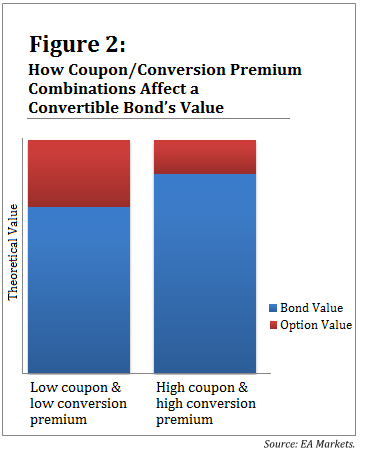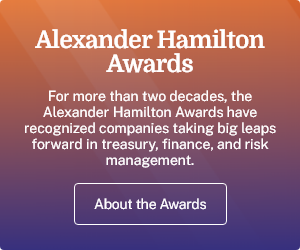 Lost among record levels of issuance of both investment grade and high yield bonds, activity is starting to percolate in a quieter corner of the capital markets: the convertible bond market. Convertible bonds are hybrid financing vehicles. They're issued as a bond, but they include an option for the bondholder to convert them into a specified number of shares of common stock in the issuing company. This embedded option, sold by the issuer to the investor, enables the issuer to lock in a lower coupon than it could for equivalent straight debt, and it enables investors to receive current income in the form of cash coupons while potentially participating in the upside of the underlying shares.
Lost among record levels of issuance of both investment grade and high yield bonds, activity is starting to percolate in a quieter corner of the capital markets: the convertible bond market. Convertible bonds are hybrid financing vehicles. They're issued as a bond, but they include an option for the bondholder to convert them into a specified number of shares of common stock in the issuing company. This embedded option, sold by the issuer to the investor, enables the issuer to lock in a lower coupon than it could for equivalent straight debt, and it enables investors to receive current income in the form of cash coupons while potentially participating in the upside of the underlying shares.
Over the past few years, historically low interest rates have made traditional bonds very attractive to issuers. Many have opted to lock in low coupons in the straight debt markets, rather than issue convertible bonds that would potentially result in future dilution of their common stock. Corporate America's focus on more traditional bonds has limited the supply of new convertible offerings. Recently, however, favorable market conditions have led to a surge in new convertible offerings, and the trend may be just getting started.
This shift has been driven by several factors. Because convertibles include both bond-like and equity-like features, the combination of low interest rates and equity prices at all-time highs makes them very attractive for issuers willing to look beyond more-familiar financing options. Recent convertible issuers have locked in low coupons and attractive conversion prices—but these favorable market conditions are hardly breaking news.
Why, then, have offerings recently increased? Equity prices are part of the explanation. A more subtle factor is the 100 basis point (bps) increase in interest rates since early May, which has led to higher coupons for straight bonds. Historically, issuance of convertible bonds has increased in rising-rate environments (see Figure 1, below), as convertible pricing is less impacted by rate increases than is equivalent straight debt. Furthermore, the higher volatility in the high yield and investment grade bond markets in May and June created uncertainty for issuers and convinced some to reconsider the timing of opportunistic financings. These factors, coupled with the strong demand from convertible investors seeking to replace older offerings that have recently matured, make it hardly surprising that some potential issuers of straight debt are considering other financing alternatives.
Flexible Arrow in the Corporate Finance Quiver
When confronted with a financing need, management teams tend to gravitate toward familiar mainstays, such as traditional loans, bonds, and common equity. However, convertible bonds are regularly used to address the same types of needs: growth capital, refinancing, acquisitions, restructuring, and share repurchase programs.
Pricing terms for convertibles vary widely based on factors such as the issuer's credit profile and characteristics of the underlying equity. Typical terms for recent offerings have included maturities of five to seven years, coupons averaging 3.00 percent, and conversion premiums from 10 percent to around 50 percent.

From the issuer's perspective, investors' willingness to accept a wide array of coupon and conversion premium combinations provides flexibility to target a specific cash coupon or conversion premium.
But issuers need to understand that cash coupons and conversion premiums are closely correlated. A company seeking to lock in the highest possible conversion price can do so by offering investors a higher coupon.
This makes sense intuitively: An option struck further above the current share price is less valuable than one that enables investors to participate in the upside of the shares sooner. As a result, investors purchasing a higher-premium convertible will require a higher coupon to achieve an equivalent value on the overall, bundled terms of the convertible bond. (See Figure 2, below.)
31 Flavors of Financing
The flexibility afforded by convertibles extends far beyond the tradeoff between coupon and conversion premium. A number of strategies are available to help issuers of convertibles address other specific corporate finance needs. For example:
Objective #1: Maximize Efficiency Of Sizable Equity Financing Solution: Concurrent Common Stock and Convertible Offering
Issuers looking to raise significant amounts of equity financing can offer convertibles simultaneously with common shares. This strategy increases the overall efficiency of an offering by simultaneously tapping multiple markets and distinct investor bases. The convertible component is typically issued as a “mandatory convertible.” A mandatory convertible differs from a convertible bond in that conversion to shares is required, not optional.
 Suppose, for example, a potential issuer wants to raise $1 billion and its share price is currently $100.If it raised the full amount by issuing common stock, it would place around 10 million new shares with equity investors. If, instead, the issuer offered $500 million worth of common stock and $500 million worth of mandatory convertibles, it could potentially reduce the overall share dilution. Common investors would need to absorb only 5 million shares up front ($500 million / $100). Mandatory convertible investors would receive a security that would pay a preferred dividend for three years (typically 5 to 7 percent per year) then convert into shares at one of a set of predetermined prices.
Suppose, for example, a potential issuer wants to raise $1 billion and its share price is currently $100.If it raised the full amount by issuing common stock, it would place around 10 million new shares with equity investors. If, instead, the issuer offered $500 million worth of common stock and $500 million worth of mandatory convertibles, it could potentially reduce the overall share dilution. Common investors would need to absorb only 5 million shares up front ($500 million / $100). Mandatory convertible investors would receive a security that would pay a preferred dividend for three years (typically 5 to 7 percent per year) then convert into shares at one of a set of predetermined prices.
Let's say the conversion premium of the mandatory convertibles is 20 percent. If the share price ends up above the conversion price of $120 after three years, investors will receive 4.17 million shares ($500 million / $120). If the share price is below the initial offering price of $100, the mandatory will convert to 5 million shares. At prices between $100 and $120, investors will receive between 4.17 million and 5 million shares. In the scenario with the most bullish stock price gains, the issuer will face less share dilution—it will issue over 800,000 fewer shares—under a concurrent financing than it would in a comparably sized equity financing.
Given the certainty of conversion, rating agencies assign a very high degree of equity credit to mandatories—up to 100 percent—which means that although it attracts convertible bond investors, a mandatory convertible does not impact a company's credit rating in the way other bonds do. In fact, the simplest mandatory is structured as preferred stock rather than as a bond. Mandatory convertibles therefore provide issuers the opportunity to protect their ratings while offering something other than straight equity. In many cases, mandatories are also designed to achieve partial tax deductibility of the coupons.
Objective #2: Opportunistic Share Repurchase Solution: Convertible-Funded Share Repurchase
Issuers can also capitalize on the enhanced stock liquidity surrounding the pricing of a convertible to repurchase shares. Typically, some portion of convertible investors will simultaneously buy the bonds and sell some common shares short in order to hedge against the equity exposure embedded in the convertible. This creates an opportunity for the issuer to step in and repurchase those shares at the time the offering is priced. If the issuer doesn't step in, the convertible investors will simply sell the shares into the market. By stepping in, the issuer can not only achieve price certainty on the repurchase price, but in most cases also repurchase shares more quickly than through an open market repurchase program. Given that the conversion price is based on the issuer's share price at the end of the marketing period, any reduction in the amount of potential selling activity helps the issuer maximize its conversion price. Recent users of this strategy have allocated 10 percent to 20 percent of the offering proceeds toward repurchasing shares.
Objective #3: Create a Debt Substitute Using The Convertible Market
Solution: Convertible Plus Call Spread Overlay
 Most traditional convertible bonds have conversion premiums that range from 10 percent to 50 percent above the issuer's current share price, averaging 30 percent. At higher conversion premiums, pricing becomes less efficient for the issuer. Given that most issuers are seeking the best of both worlds—a low cash coupon coupled with the highest possible conversion premium—how can issuers achieve a high premium without impacting pricing efficiency?
Most traditional convertible bonds have conversion premiums that range from 10 percent to 50 percent above the issuer's current share price, averaging 30 percent. At higher conversion premiums, pricing becomes less efficient for the issuer. Given that most issuers are seeking the best of both worlds—a low cash coupon coupled with the highest possible conversion premium—how can issuers achieve a high premium without impacting pricing efficiency?
The solution for many is a financing strategy developed by the investment banking community. Referred to as a “convertible with bond hedge and warrants” transaction, or more generically as a “call spread overlay,” this strategy consists of three components (see Figure 3):
First, the issuer sells a plain-vanilla convertible bond with a traditional conversion premium (for example, 30 percent above the current share price) to convertible investors.
Second, the issuer uses a portion of the proceeds to purchase a hedge from the underwriting bank(s) of the embedded call option sold in the convertible. The hedge is a purchased call struck at the conversion price of the convertible bond (+30% in this example). The hedge eliminates dilution that the issuer might otherwise face if the bonds convert. If convertible investors exercise their rights to exchange bonds for shares, the underwriters will deliver shares to the issuer, which can then be used to satisfy the issuer's obligation to investors. Economically, the combination of these first two steps creates synthetic straight debt.
Finally, the issuer separately sells call options to the underwriters that are struck well above the +30% conversion price (for instance, at 75 percent higher than the current share price). The number of warrants sold is the same as the number of shares underlying the convertible, and the maturity of the warrants is typically slightly longer than the maturity of the convertible bond. The proceeds from the sale of these warrants partially offsets the costs of the purchased hedge.
When all three steps are combined, the issuer has used a portion of the initial proceeds (typically 6 to 10 percent) to raise the effective conversion premium (from +30% to +75% in this case). The issuer has essentially used the convertible market to create a debt-like financing with a low cash coupon and significantly reduced the probability of dilution.
Getting Under the Hood
Given the number of product variants and potential corporate finance applications, how does a management team efficiently compare convertibles with more familiar financing strategies? Fundamentally, any financing instrument must fit into the issuer's long-term financial and strategic objectives. Among other things, the issuer must consider its intended use of the proceeds, its desire to add leverage to the balance sheet, and the potential for future share dilution. Management should be sure to scrutinize how product-specific features interact with broader corporate finance objectives in terms of:
• Financial flexibility. Most issuers give themselves the flexibility to choose whether to settle a convertible in cash, shares, or a combination if the share price ends up above the conversion price. Many elect to settle at least the principal amount of a convertible bond in cash; a few convertible bonds have even hard-wired the documents to settle everything in cash. While this settlement mechanism significantly reduces share dilution, it does create a future cash refinancing obligation that must be factored into the issuer's long-term financing plan.
• Dilution. The ability to establish a conversion price well above the current share price reduces potential dilution relative to a traditional equity offering. However, issuers should keep in mind that convertibles include standard provisions that adjust the conversion price in the event of stock splits, spinoffs, tender offers, changes in dividends, and other corporate finance events. Such adjustments could impact the degree to which an outstanding convertible bond causes future share dilution.
• Accounting. Issuers that incorporate the flexibility to settle the principal amount of a convertible bond in cash are also required to bifurcate the security into “debt” and “equity” components for reporting purposes. The end result is (non-cash) interest expense in addition to the stated cash coupon.
Convertibles are a highly flexible form of financing that can address a wide array of corporate needs. Current market conditions present a clear opportunity for issuers, and recent issuers have gotten ahead of the curve to lock in attractive terms. But the product does have its own distinct terminology and nuances, and it is initially less familiar to most finance teams than other forms of financing.
When a company understands that it has myriad options for issuing convertible bonds, the question becomes how to compare the flexibility provided by convertibles against the time required to evaluate the product for most first-time issuers. The good news for prospective issuers is that convertibles have been around in some form for decades, and both traditional convertibles and the more specialized strategies described above are well-understood by the legal and accounting communities. To the extent that further analysis is warranted, independent advisors can also help management teams work through the nuances of these products.
Management teams considering using convertibles should ensure that they invest the necessary time, and engage advisors early in the process, to make the most of the product line's flexibility. It is noteworthy that there is a long history of repeat issuers in the convertible market. Perhaps that is the most telling sign that management teams who put in the time to understand this vehicle view the effort as worthwhile.
 Greg Holden is a Director with EA Markets LLC, a corporate finance and capital markets advisory firm based in New York City. Holden has over 12 years of experience structuring equity-linked and equity derivatives securities.
Greg Holden is a Director with EA Markets LLC, a corporate finance and capital markets advisory firm based in New York City. Holden has over 12 years of experience structuring equity-linked and equity derivatives securities.
Additional articles from EA Markets:
Mitigating Counterparty Risk in Derivatives Trades by Christine Ginfrida
© 2025 ALM Global, LLC, All Rights Reserved. Request academic re-use from www.copyright.com. All other uses, submit a request to [email protected]. For more information visit Asset & Logo Licensing.




